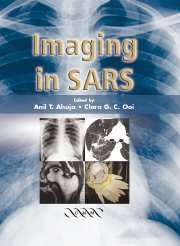Book contents
- Frontmatter
- Contents
- Contributors
- Preface
- 1 The Epidemiology of Severe Acute Respiratory Syndrome: A Global Perspective
- 2 The Role of Emergency Medicine in Screening SARS Patients
- 3 Severe Acute Respiratory Syndrome Outbreak in a University Hospital in Hong Kong
- 4 Imaging of Pneumonias
- 5 The Role of Chest Radiographs in the Diagnosis of SARS
- 6 Chest Radiography: Clinical Correlation and Its Role in the Management of Severe Acute Respiratory Syndrome
- 7 The Role of High-Resolution Computed Tomography in Diagnosis of SARS
- 8 The Role of Imaging in the Follow-up of SARS
- 9 Treatment of Severe Acute Respiratory Syndrome
- 10 SARS in the Intensive Care Unit
- 11 Imaging of Pneumonia in Children
- 12 Imaging and Clinical Management of Paediatric SARS
- 13 Imaging of SARS in North America
- 14 Radiographers' Perspective in the Outbreak of SARS
- 15 Implementation of Measures to Prevent the Spread of SARS in a Radiology Department
- 16 Aftermath of SARS
- 17 Update on Severe Acute Respiratory Syndrome
- Index
3 - Severe Acute Respiratory Syndrome Outbreak in a University Hospital in Hong Kong
Published online by Cambridge University Press: 27 October 2009
- Frontmatter
- Contents
- Contributors
- Preface
- 1 The Epidemiology of Severe Acute Respiratory Syndrome: A Global Perspective
- 2 The Role of Emergency Medicine in Screening SARS Patients
- 3 Severe Acute Respiratory Syndrome Outbreak in a University Hospital in Hong Kong
- 4 Imaging of Pneumonias
- 5 The Role of Chest Radiographs in the Diagnosis of SARS
- 6 Chest Radiography: Clinical Correlation and Its Role in the Management of Severe Acute Respiratory Syndrome
- 7 The Role of High-Resolution Computed Tomography in Diagnosis of SARS
- 8 The Role of Imaging in the Follow-up of SARS
- 9 Treatment of Severe Acute Respiratory Syndrome
- 10 SARS in the Intensive Care Unit
- 11 Imaging of Pneumonia in Children
- 12 Imaging and Clinical Management of Paediatric SARS
- 13 Imaging of SARS in North America
- 14 Radiographers' Perspective in the Outbreak of SARS
- 15 Implementation of Measures to Prevent the Spread of SARS in a Radiology Department
- 16 Aftermath of SARS
- 17 Update on Severe Acute Respiratory Syndrome
- Index
Summary
Epidemiology: University Hospital experience
In March 2003, there was an outbreak of atypical pneumonia in Hong Kong and our institution was at its epicentre. Epidemiological investigations revealed that the initial outbreak at our institution was related to a single index case admitted to one of our medical wards.
In the early phase of the outbreak, the index case infected
55 health care workers in the same ward;
16 medical students who clinically examined the index case;
54 patients who were either nursed in the same ward or had visited their relatives.
It is postulated that the use of nebulized salbutamol for muco-ciliary clearance may have potentiated its transmission.
Diagnosis of SARS
At the time of writing, the diagnosis of severe acute respiratory syndrome (SARS) is still based on clinical and epidemiological information as in our previously reported cohort. According to the WHO case definition, patients are classified as ‘suspect’ or ‘probable’ cases, as discussed in the earlier chapter (Chapter 1). Cases are excluded if an alternative diagnosis can fully explain their illness. However, clinicians are advised that patients should not have their case definition category downgraded while awaiting results of laboratory testing or on the bases of negative results.
- Type
- Chapter
- Information
- Imaging in SARS , pp. 29 - 32Publisher: Cambridge University PressPrint publication year: 2004

